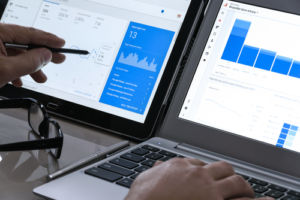Google Analytics is easy to use and can tell you what your customers are looking for at any given time.
Google Analytics will help you:
- Understand your customers, their preferences and online behaviours.
- Find the keywords that are used to find your products and services.
- Help you channel traffic through your website and to key landing pages.
- Identify how traffic comes to your website and the mix of that traffic.
- Focus your resources – both money and time – on online advertising campaigns that deliver the best return on investment.
It’s easy to use
Google Analytics has transformed how businesses analyse and act on their website traffic. Many larger businesses no longer pay for web analytics, finding that Google Analytics meets most of their needs. There are exceptions – some eCommerce businesses and online publishers which rely on digital advertising for revenue will use other specialist analytics software on their websites to provide granular data or commercial metrics they need.
For many smaller businesses, Google Analytics has provided rich new sources of data that can be used to make everyday business decisions and also to assist with their strategic planning.
“The Google Analytics Academy provides help to novice users. It provides eLearning courses along with a dedicated YouTube channel and an analytics blog.”
The obvious benefits
- Keyword insights: you may think you know your customer or your prospective customer. You may also think you know the words and phrases they will use to find your business or your products or services. The reality is that you don’t really know. Google Analytics will give you objective evidence about the important keywords used based on the data currently being used by your target audience.
- Customer insights: once you understand the keywords used, you can then understand through analytics more about their online behaviours. For instance, you can segment your customers or prospects into groups who use your brand name as a search term and those who don’t. Then you can compare each group’s behaviour on your website. Through this type of data, you can optimise your website to maximise goals such as online visibility, engagement and conversion.
- Traffic insights: analytics will help you identify the traffic that lands on your site and what happens to that traffic. That will help you understand which search engines, social media or paid advertising campaigns are referring traffic and lead to a conversion into a sale. That will help you decide on where you should focus your advertising budget and your energies.
- Page analytics: you can understand if each page is meeting user needs and business goals. You can set up analytics so that it reports how well each page is performing and whether or not it is sending potential leads down the “funnel” to make a purchase, complete a form, register for a service or simply contact you through your “Contact Us” page.
- Better decision making: using this data you can make better decisions based on real data. You can decide which marketing channels to focus on. You can decide on where to make web development or content decisions. You can track performance daily, weekly, monthly – or whatever interval best suits your business. Over time this data will build up into a long term view about what is driving your target audience to and from your website. This can allow you to make some strategic business decisions.

Designed for ‘non-techies’
Google Analytics is designed to be used by non-technical people. The set-up – placing a tracking code on your website – is best handled by a web developer. However, you should ensure you control the Google Analytics account yourself and that you do the administrative set up (username and password).
Apart from the fact that the account provides access to sensitive data that relates to your business, if a third party has access to your account there could be handover issues if you want to switch developer at some stage in the future. This has been the unfortunate experience of some business owners who have had disagreements with web developers or who decide to switch to new suppliers and who find themselves locked out of their Google Analytics accounts.
While there are courses available on how to use Google Analytics, the reality is that Google itself provides a lot of training and support for free. The Google Analytics Academy provides help to novice users. It provides eLearning courses along with a dedicated YouTube channel and an analytics blog.
Most people who use analytics are self-taught. The analytics “interface” – what you are presented on the screen – is easy to use. To get maximum benefit from Google Analytics, you need to set goals and customise the settings to ensure that the reports that are generated meet your business needs.
Other analytics tools
Some businesses opt to run other analytics packages on their sites. For smaller businesses, other popular choices include:
- OpenWeb Analytics: this open source platform is completely free to use, has no data limits and can be used on an unlimited number of websites. Advantages include conversion statistics, visitor flow, mouse movement records and multi-page click heatmaps, but the downside is you must install it on your web server yourself.
- StatCounter: an Irish platform, StatCounter can be used to monitor activity in real time, and is free to use. Advantages include quick results, good individual tracking and an easy set-up process.
3 Action Points






